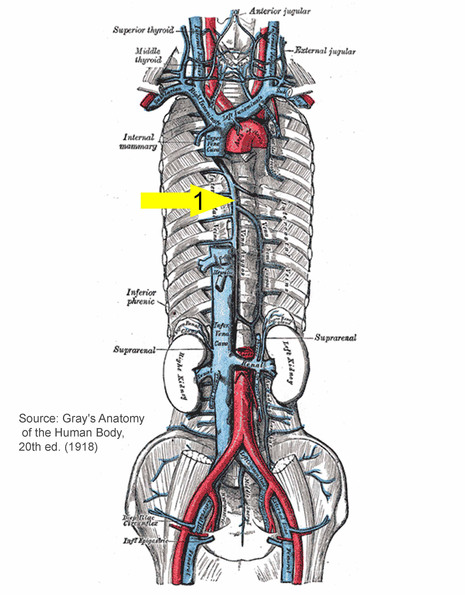(09) A 41-year old woman develops superior vena cava syndrome due to a tumor located at the junction of the right and left brachiocephalic veins. What vein can still provide direct inflow into her superior vena cava?
Explanation
Correct Answer:
Azygos vein
Take-Home Message:
The azygos vein (arrow 1, below) can provide an important collateral pathway for return of blood to the heart in cases of superior vena cava (SVC) obstruction [also known as SVC syndrome].
Explanation of Correct Answer:
The azygos and hemiazygos system of veins are located in the posterior mediastinum and provides an important potential collateral pathway for blood when there is either blockage of the superior or inferior vena cava. Since these veins do not contain valves, blood can easily flow in either direction. If there is obstruction of the superior vena cava or brachiocephalic veins superior to the inflow of the azygos, blood from the upper body can enter the azygos system from anterior to posterior intercostal veins and still reach the superior vena cava below the point of obstruction via the azygos arch. If the obstruction is below the entry point of the azygos into the superior vena cava, this same system of veins can still return blood to the heart from below via connections of the azygos to the inferior vena cava or its abdominal tributaries.
Explanation of Incorrect Answers:
The internal jugular vein joins the subclavian veins to return blood flow into the brachiocephalic veins. This vein does not provide a route for blood to bypass the blockage at the junction of the brachiocephalic veins.
The external jugular vein joins the subclavian vein more laterally, combining with the internal jugular veins to form the brachiocephalic veins. This vein does not provide a route for blood to bypass the blockage at the junction of the brachiocephalic veins.
The internal mammary vein returns blood flow via the brachiocephalic trunk. This vein does not provide a route for blood to bypass the blockage at the junction of the brachiocephalic veins.
Clinical Pearls:
Non-small cell (bronchogenic) cancer is the major cause of malignant SVC syndrome, while histoplasmosis is the most common cause of benign SVC syndrome.
For more information on this topic, please click on the following link(s):
(While these web sources have been vetted by our content experts, please use them with caution --- the peer-reviewed literature should be the ultimate source of medical information.)
http://www.emedicine.com/emerg/topic561.htm
http://en.wikipedia.org/wiki/Azygos_vein

Azygos vein
Take-Home Message:
The azygos vein (arrow 1, below) can provide an important collateral pathway for return of blood to the heart in cases of superior vena cava (SVC) obstruction [also known as SVC syndrome].
Explanation of Correct Answer:
The azygos and hemiazygos system of veins are located in the posterior mediastinum and provides an important potential collateral pathway for blood when there is either blockage of the superior or inferior vena cava. Since these veins do not contain valves, blood can easily flow in either direction. If there is obstruction of the superior vena cava or brachiocephalic veins superior to the inflow of the azygos, blood from the upper body can enter the azygos system from anterior to posterior intercostal veins and still reach the superior vena cava below the point of obstruction via the azygos arch. If the obstruction is below the entry point of the azygos into the superior vena cava, this same system of veins can still return blood to the heart from below via connections of the azygos to the inferior vena cava or its abdominal tributaries.
Explanation of Incorrect Answers:
The internal jugular vein joins the subclavian veins to return blood flow into the brachiocephalic veins. This vein does not provide a route for blood to bypass the blockage at the junction of the brachiocephalic veins.
The external jugular vein joins the subclavian vein more laterally, combining with the internal jugular veins to form the brachiocephalic veins. This vein does not provide a route for blood to bypass the blockage at the junction of the brachiocephalic veins.
The internal mammary vein returns blood flow via the brachiocephalic trunk. This vein does not provide a route for blood to bypass the blockage at the junction of the brachiocephalic veins.
Clinical Pearls:
Non-small cell (bronchogenic) cancer is the major cause of malignant SVC syndrome, while histoplasmosis is the most common cause of benign SVC syndrome.
For more information on this topic, please click on the following link(s):
(While these web sources have been vetted by our content experts, please use them with caution --- the peer-reviewed literature should be the ultimate source of medical information.)
http://www.emedicine.com/emerg/topic561.htm
http://en.wikipedia.org/wiki/Azygos_vein

Tidak ada komentar:
Posting Komentar